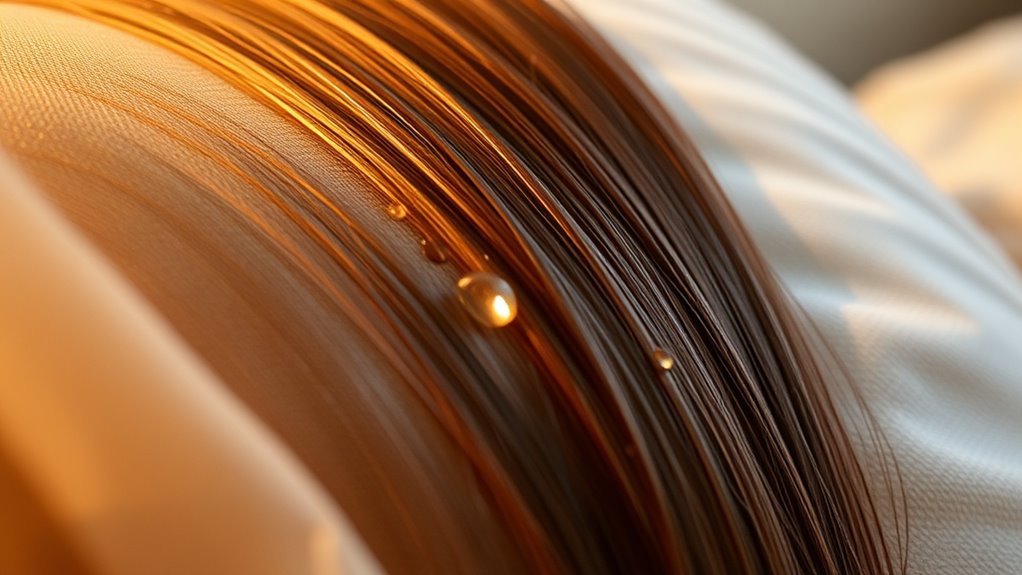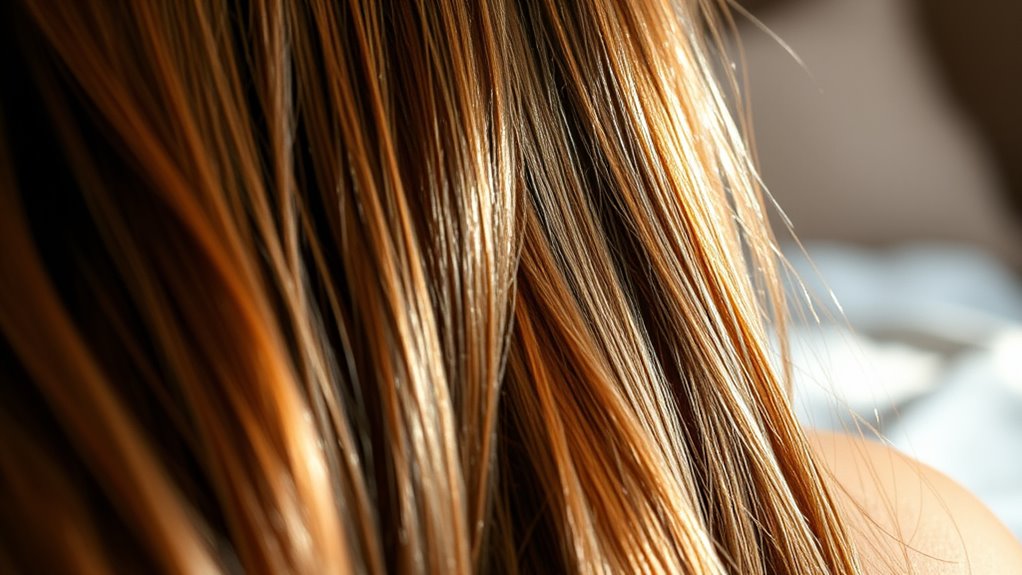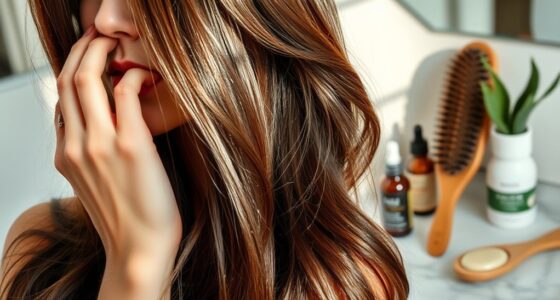Hair slugging is a simple, effective way to nourish your hair overnight by applying oils like coconut, argan, or jojoba to your scalp and strands. You’ll want to use a small amount, focusing on dry, damaged ends, then cover your hair with a shower cap or silk scarf to trap heat. In the morning, wash thoroughly to enjoy smoother, shinier hair and a healthier scalp. Keep going, and you’ll discover tips to maximize your hair’s benefits even more.
Key Takeaways
- Apply a suitable oil (coconut, argan, castor, or jojoba) to clean, dry hair and scalp for maximum nourishment.
- Use fingertips or a small brush to evenly distribute oil, focusing on dry or damaged ends.
- Cover hair with a shower cap or silk scarf to trap heat and enhance oil absorption overnight.
- Wash hair thoroughly in the morning to remove excess oil while preserving natural moisture.
- Regularly practice hair slugging to improve shine, manageability, and overall scalp health.

Have you heard of hair slugging? It’s a beauty trend that’s gaining popularity because of its simple yet effective way to nourish your hair overnight. The core idea involves applying oil to your hair and scalp before bed, then sealing it with a shower cap or a silk scarf. This method allows the oils to deeply penetrate and hydrate your strands, resulting in smoother, shinier hair in the morning. But beyond the visible benefits, hair slugging also supports overall scalp health, which is vital for strong, healthy hair. When your scalp is healthy, it’s less prone to dryness, dandruff, and irritation, creating the perfect environment for hair growth. That’s why mastering oil application techniques is fundamental for maximizing the benefits of hair slugging.
Your first step is choosing the right oil. Popular options include coconut, argan, castor, or jojoba oils—each offering unique advantages for your hair and scalp. Once you’ve selected the oil, focus on applying it correctly. Start with clean, dry hair to prevent trapping dirt or pollutants. Use your fingertips or a small brush to massage the oil into your scalp, working from the roots outward. This stimulates blood flow and ensures the oil reaches the scalp’s surface, promoting scalp health. Don’t forget to distribute the oil evenly through the lengths of your hair, paying extra attention to the ends, which tend to be drier and more prone to damage.
When applying oil, keep in mind that less is often more. You want enough to coat your strands without oversaturating, which can lead to greasy hair and difficulty washing out. Once the oil is in place, cover your hair with a shower cap or silk scarf to trap heat and enhance absorption. Sleep with this protective layer on, allowing the oil to work its magic overnight. Regularly practicing proper application techniques can maximize the benefits of hair slugging. In the morning, you’ll want to wash your hair thoroughly, ensuring all the product is removed without stripping away natural oils. This process leaves your hair feeling soft, manageable, and shiny, while also supporting scalp health by reducing dryness and buildup.
Practicing good oil application techniques is essential for achieving ideal results. Regularly incorporating hair slugging into your routine can help maintain a healthy scalp and improve hair quality over time. Remember, consistency is key, and paying attention to how your scalp responds will help you adjust your approach as needed. So, if you’re looking for a simple, natural way to boost your hair’s health, give hair slugging a try—your scalp and strands will thank you.
Frequently Asked Questions
Can Hair Slugging Help With Scalp Conditions?
Yes, hair slugging can help improve scalp health by moisturizing and soothing the scalp. Using oils overnight can reduce dryness and irritation, but it’s important to avoid excess oil buildup which can clog hair follicles. Regularly cleansing your scalp helps prevent oil buildup, while slugging keeps your scalp nourished. Just be sure to use light oils and don’t overdo it, so your scalp stays healthy and balanced.
Is Hair Slugging Suitable for All Hair Types?
Hair slugging isn’t suitable for all hair types. If you have high porosity hair, natural oils tend to penetrate easily, making slugging beneficial for moisture retention. However, if you have low porosity or fine hair, it might weigh your hair down or cause buildup. Always consider your hair porosity and how your scalp reacts to natural oils before trying slugging, and adjust the oils accordingly.
How Often Should I Do Hair Slugging?
You should do hair slugging 1-2 times a week, especially if your hair has high porosity and absorbs oils quickly. Some worry it might weigh down their hair, but with proper application, you avoid excess buildup. Adjust frequency based on your hair’s oil absorption; if it feels greasy or heavy, cut back. Regular slugging helps retain moisture and improves overall hair health without overdoing it.
Are There Any Risks or Side Effects?
Yes, there are risks to consider with hair slugging. You could develop oil allergies if you’re sensitive to certain oils, which may cause scalp irritation or inflammation. Additionally, leaving oils on your hair overnight might lead to damage if not properly washed out, especially if oils clog hair follicles or cause buildup. To minimize these risks, choose gentle oils suited for your hair type and make sure thorough cleansing in the morning.
What Oils Are Best for Hair Slugging?
You’ll love the irony—your hair’s best friends are simple oils like argan, coconut, and jojoba, which seem humble but pack a punch. For ideal oil absorption, create gentle oil blends that penetrate deeply without weighing hair down. These oils nourish and hydrate overnight, making your hair shine. Just remember, less is more—overdoing it can hinder absorption and cause buildup, so choose wisely for healthy, luscious locks.
Conclusion
By embracing hair slugging, you’re wrapping your strands in a nourishing embrace that works while you sleep. Think of it as giving your hair a nightly spa treatment, letting the oils seep in and work their magic. With consistent practice, your hair will thank you with increased shine, softness, and health—like a garden blooming in spring. So go ahead, indulge in this simple ritual, and wake up to hair that feels as radiant as dawn’s first light.









